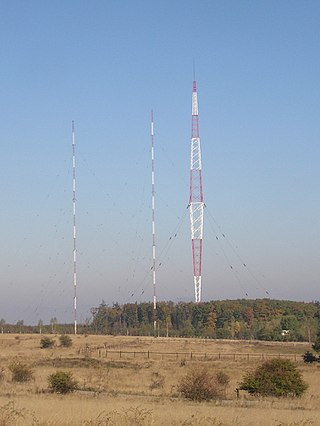Telecommunications in Botswana include newspapers, radio, television, fixed and mobile telephones, and the Internet.

Telecommunications in Bulgaria include radio, television, fixed and mobile telephones, and the Internet.
Telecommunications in Dominica comprises telephone, radio, television and internet services. The primary regulatory authority is the National Telecommunication Regulatory Commission which regulates all related industries to comply with The Telecommunications Act 8 of 2000.
Telecommunications in Gabon include radio, television, fixed and mobile telephones, and the Internet.
Telecommunications in Guinea include radio, television, fixed and mobile radio, and the Internet.
Telecommunications in Guinea-Bissau include radio, television, fixed and mobile telephones, and the Internet.
Telecommunications in Jamaica include the fixed and mobile telephone networks, radio, television, and the Internet.
Telecommunications in Mozambique include radio, television, fixed and mobile telephones, and the Internet.
Telecommunications in Nicaragua include radio, television, fixed and mobile telephones, and the Internet.
Telecommunications in Saint Lucia include internet, radio, television, and mobile and landline phones.
Telecommunications in Suriname includes radio, television, fixed and mobile telephones, and the Internet.
Telecommunications in Trinidad and Tobago include radio, television, fixed and mobile telephones, and the Internet.
In Venezuela the first law on telecommunications was approved in 1940. It identified the responsibility of the state in regard to telephone and other telecommunication systems, including radio and television services.
Communications in Barbados refers to the telephony, internet, postal, radio, and television systems of Barbados. Barbados has long been an informational and communications centre in the Caribbean region. Electricity coverage throughout Barbados is good and reliable. Usage is high and provided by a service monopoly, Barbados Light & Power Company Ltd..
Telecommunications in Belize include radio, television, fixed and mobile telephones, and the Internet.
Telephones - main lines in use: 110,300 (2007)
country comparison to the world: 137
This is a list of Communications in Saint Kitts and Nevis.
Communications in Grenada
Telecommunications in Guyana include radio, television, fixed and mobile telephones, and the Internet. Early telecommunications were owned by large foreign firms until the industry was nationalized in the 1970s. Government stifled criticism with a tight control of the media, and the infrastructure lagged behind other countries, Guyana Telephone and Telegraph Company (GT&T) holding a monopoly on most such services. In a 2012 census report on Guyanese households, 55.5% had a radio, 82.7% had a television, 27.8% had a personal computer, and 16.2% had internet at home, 49.3% had a telephone landline, and 70.6% had a cellular phone.
Telecommunications in Angola include telephone, radio, television, and the Internet. The government controls all broadcast media with a nationwide reach.

